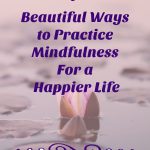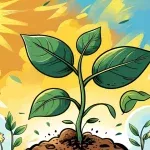How to practice mindfulness for a happier life
What are you doing while you’re reading this?
Chances are decent that you’re reading it on your phone, maybe while cooking dinner, sitting at the park while the kids play, or maybe you’re eating lunch at your desk while you read.
And that, in itself, is a problem.
You see, there are these silly little things called stress, anxiety, worry, and frustration that we all experience from time to time, and some of us more than others and one thing that I have learned, maybe better than most, is just how damaging it can be to have those emotions in your daily life.
But how can you beat them? How can you avoid them?
You can kiss them goodbye by learning how to practice mindfulness.
What is being mindful?
In the simplest explanation, being mindful basically just means being present in the here and now, and focusing on one thing at a time.
Sure, it sounds easy enough, but are you still eating your lunch while you read this?
One of the hardest things to do in today’s world is to literally focus on just one thing at a time. I’ll give you an example.
As I’m typing this article, you might think I’m single-focused on “writing a good article” but I’m also thinking about what’s being said now, what will be said, formatting, etc. Multiple senses are being triggered, from the feel of the keys under my fingers to the sight of the words coming out onto the page to the sound of the keys clacking.
The challenge is to just pick one of those many things to focus on, but at the risk of missing out on the joy of experiencing the rest of them.
And that, my sweet friend, is how to practice mindfulness – being aware, focusing, and acknowledging the various thoughts, sensations, etc. that surround you.
What are some benefits of practicing mindfulness?

There was a time in my life when practicing mindfulness really didn’t matter much — I was young, a newlywed, and we lived our life really quite in the moment anyway, as early 20-somethings often do. I didn’t even know how to practice mindfulness or why I needed to.
But then the harsh reality of growing up hit us. Hard.
Before our first wedding anniversary, we were unexpectedly homeless from an apartment fire. Thank God for parents with an extra bedroom, the fire being above us leading to only water damage on our things, and the fact that we had JUST signed the mortgage paperwork on our house the day before the fire (we closed just 1 month later).
Fast forward a few years, and we were blindsided by leukemia diagnosis for my husband…with a 20-30% survival expectation…on the day our second child was born.
The things I could tell you about stress, anxiety, worry…
It was during my husband’s treatments while I adjusted to being a mom of 2 that I came across mindfulness as a possible solution to help lessen my constant state of feeling like my head was going to explode or that I’d drown in my own tears of worry.
Like with anything, it took time, practice, and patience, but the benefits of learning how to practice mindfulness, regularly, became obvious quite quickly. When I started implementing mindfulness techniques, this is what happened.
This is how practicing mindfulness helped me through this tough time
- It helped me feel less worried about his diagnosis. He was handling treatments well, his doctors were optimistic. If he only had a short time left, it was better to spend it in the moment than looking back and wishing.
- It calmed me down when dealing with 2 screaming kids. When our daughter was born, we had 2 under 2 for a little while, and that’s tough! For a while, I would get so angry when our daughter (the youngest) needed to be held and rocked for so long to fall asleep. When I realized she might be my last baby, I learned to soak up those moments a little better.
- I learned how to handle stress and anxiety more reliably. I knew the anxiety wasn’t going to magically go away (2.5 years later it’s still here), but it has definitely lessened. Partly because of a miraculous, unexplained complete remission for my husband, partly because while finding mindfulness activities that worked for me I learned more about myself, my body’s reactions to stress, and how to counteract it successfully.
I can’t tell you 100% how applying mindfulness techniques will affect you, but I can assure you that it’s something you need to incorporate into your daily life, if for no other reason than life is short and could end in an instant. Spend what time you having living in the present, as best as you can.
Ways to be mindful – how to practice mindfulness.
I’ve already given you a couple of examples of applying mindfulness techniques, above, but that isn’t enough to teach you how to practice mindfulness.
The good news, though, is that it really is easy to use mindfulness techniques in everyday life, so long as you are willing to put in the little bit of effort it takes to make it a habit.
Here are 7 mindfulness techniques — one for every day of the week, if you like! — to help you live in the moment, embrace whatever today brings, and truly find the joy in life that we all seek.
7 Mindfulness Techniques to help you live a happier life
1) Practice mindfulness as soon as you wake.
There are two good ways to do this, so try both and see which one gives you more peace to decide which one is right for you.
The first way to practice mindfulness right when you wake up is to meditate.
No, you don’t need to go sit on a yoga mat in nature and say “ohm” on repeat (although the being in nature part is a good choice).
Meditating can be as simple as sitting cross-legged on your bed, hands on your knees, and with a 5-minute timer running just focus on the sound and feel of your breathing.
By forcing yourself to really concentrate on the bodily sensation of breathing, you’ll (mostly) block out other sounds around you, other feelings (since your mind is turned to your diaphragm and ribcage), and while your subconscious mind might still be working in the background, when done right you won’t be thinking about the day’s tasks or upcoming weekend plans.
Another mindfulness activity for straight out of bed is to let your mind wander.
Similar to meditating but with a little more flexibility, simply clear your mind of all thoughts and see what happens.
If you’re anything like me, chances are good your first thought after that will be about the day to come. Try writing some positive prompts in a little notebook, one per page, and keeping them next to your bed, where you can easily grab it each morning to see where the next prompt will take you. Maybe these will be motivational quotes, philosophical questions, or simple single words, such as a color or an animal.
If you’re more the journaling type, try getting a mindfulness journal and recording those wandering thoughts. This could be a useful tool to re-read the morning’s wanderings right before bed, to help you again clear your mind for a good night’s sleep. Check out the one below! (affiliate link) Click the image for more details and to grab a copy!
2) Make a point to only do one thing at a time.
As a work-at-home mom, I 100% understand how absurd and impossible that statement sounds sometimes! But I’ll argue for it with this: if you constantly tell yourself you MUST do more than one thing at a time, your mind then sets that as the standard for yourself.
If your mind thinks you’re only doing a good job when you’re overly busy, it will make you feel like a failure for slowing down.
I want you to really think about that for a minute.
Especially in today’s busy world, where everyone is eating lunch while looking at their phones, where we listen to audiobooks while we drive, and where we expect everything right now because we just couldn’t live without instant gratification…where is there room for someone who puts on the brakes and decides to enjoy just one thing at a time?
Talk about a culture revolution.
But if you’re talking on the phone while you’re changing a diaper, you’re missing out on an opportunity to give your baby 100% of your attention. You’re missing out on tickles, talking (you or them), giggles, or even a learning opportunity (if you can’t say “gimme those feets!” because you’re on the phone, well, Baby isn’t learning what their “feets” are right now).
If you take a long drive on the highway, instead of worrying about listening to an audiobook of the latest bestseller or self-help book, focus that would-be attention on the scenery around you. Notice the trees, the colors, the wildlife. Roll down the windows and feel the wind, the difference of sun on your arm through the glass versus without it, and hear the sounds of the cars, the birds, whatever it is that your ears can find to listen to.
It’s amazing how much more magical life can feel when you make a point to stop and give each thing the respect of your attention that it deserves.
3) Choose a recurring prompt to give yourself pause (and permission) to be mindful.
This could be an alarm on your phone that repeats daily, or a self-made habit such as meditating for 5 minutes every time you get into your car, no matter how many times per day that happens.
Maybe you choose a color and every time you notice that color you make a point to stop and be mindful for a few minutes.
Whatever your cue is, this is a great way to help you fit mindfulness activities into your routine activities fairly seamlessly. Even just looking around the waiting room of the doctor’s office, you might see the color on a poster and spend your wait being mindful instead of numbly scrolling through Facebook.
Have you ever just sat and looked — really looked — at the posters or wallpaper or chairs in your doctor’s waiting room? Have you ever had the chance to know what it feels like to be the only one in a crowded room not totally lost to the world with your eyes glued to a phone screen?
Give it a try, and you’ll find that you feel so much peace in those moments, knowing that you’re centering yourself and taking a minute to disconnect from the busy world around you.
4) Eat mindfully.
As you add in more and more mindfulness techniques into your everyday routines, a BIG way to add more mindfulness into your life is to practice “mindful eating.”
I know, it sounds a little weird. But you’ve already done this, you’ve just never made it a point to make it a habit.
You’ve gone to a nice restaurant before and ordered something that looked like it was going to taste amazing. Sure, you had a conversation with your dinner partner(s) during that meal.
But for just a moment, when you took your first bite, every bit of you was likely tuned in to that food, if even for a split second when it hit your tongue.
For just a second, every sense you had was attuned to that meal in front of you. You wanted to know the taste, the texture, the smell, the sight – everything. For just a second, you were being incredibly mindful about what you had to eat, or else how would you know if it was worth getting again, worth recommending, etc?
Try and have that same level of focus for every meal you eat, not just the special ones.
Hear and feel the crunch of fresh veggies in your mouth. Smell the mouth-watering goodness of that grilled chicken on your plate. Appreciate the artful presentation of your sushi.
Whether you’ve got a gourmet meal or a bowl of Cheez-its in front of you, make a point to take in as much about that food as you can, using all your senses.
(But try not to totally ignore your family when they’re talking to you during dinner!)
5) Get lost in a favorite activity.

I personally think this is one of those rare things that’s more easily done than said!
Have you ever, for example, picked up a book and planned to read for 20 minutes before bed, only to find that an hour has come and gone?
Have you ever been having a good time — at a party, a concert, hanging out with a friend, playing with your kids — and look at a clock only to be shocked by how much time has passed?
One of the best for how to practice mindfulness in your everyday life and significantly decrease your overall stress and anxiety levels is to have something you love doing in which you can 100% lose yourself.
For me, that’s definitely reading. For you, it might be cooking, going on a nature walk, or even watching TV. Honestly, it doesn’t really matter what it is, what matters is what it does for you.
If you can find an activity where your mind gets so absorbed that you lose the world around you, a magical little side effect happens — you’ll typically also lose sight of the nagging thoughts inside your mind as well.
When I was first dealing with having a sick husband (who was stuck in the hospital for the first month after diagnosis) and being home alone with a newborn + 2-year-old all at the same time, I constantly felt that fight-or-flight sensation, pretty much 24/7. My dad had the wonderful suggestion to say “you love reading, why not try to read a book every night after the kids are asleep?”
I argued about how I didn’t have the time, I had so much to catch up on with my chores and pets to take care of, how I just couldn’t possibly get into the right frame of mind to really get into a book and it would feel like a chore and just make me even more worked up.
Well, turns out my dad knows me maybe better than I do. Let’s just say that I have read a LOT of books since then.
I can’t think of any better way to explain why “getting lost” works, other than to use my dad’s words: you need a chance to get out of your own mind sometimes.
When you can force your mind to clear itself from all the negatives, worries, fears, etc that might be swirling around up there, you give your mind a chance to literally slow down.
You can’t run a car at highway speeds forever or you’ll blow up the engine. Your mind needs a solid rest now and then, too.
6) Work on prioritizing acceptance and gratitude.

This one sounds so cheesy, I know, but honestly, it’s an incredible way to essentially retrain your mind to focus on the good instead of the negative. It’s probably one of the best mindfulness techniques!
What I mean by prioritizing acceptance is that rather than complaining about how something isn’t going your way, you need to make a point to acknowledge that it is what it is, and maybe it’s just outside of your control.
Maybe this is best worded in the popular Serenity Prayer:
“God, grant me the serenity to accept the things I cannot change,
Courage to change the things I can,
And wisdom to know the difference.”
Which leads to the concept of learning gratitude and making a point to express that gratitude regularly.
(Bonus points if you make a daily gratitude session a part of your daily family mindfulness activities!)
Have you ever noticed how some people are just constant Negative Nancys? They just seem to never have anything good to say, and they’re always just miserable.
Being around them even tends to bring other people down, too.
It’s also these negative people who tend to be most irritated by people who are thankful, positive, and optimistic. Interesting, isn’t it? This might be one of the few times when opposites don’t attract.
By making a habit to be grateful, you are giving yourself permission to focus on the good things in life, and helping to crowd out the negatives that bother you.
The reason that this matters and is a great mindfulness technique is that it is simply the truth that negativity makes us physically feel bad, while positivity has no ill effects. Think about it.
Having a bad cold and being in a crappy mood tend to go hand in hand. Is it because miserable people get sick more often, or because people who get sick more often tend to be more sour in their moods? Maybe it’s a chicken-and-egg scenario, but you’re fairly unlikely to find someone on the worst day of a bad cold all smiles and sunshine about how wonderful life is.
The point is, the more good things you notice in life, the better you will retrain your mind to focus on the good. As humans, we tend to gravitate towards the negatives. There is more to say when you’re complaining then when you’re content. It makes for more airtime when the news stations report bad news than good.
Go against the grain and become the bright light that this world needs.
7) Learn to stop limiting yourself.
Some might say that it is practicing mindfulness to know your limitations and not push yourself past what you know you’re capable of doing.
But that, in itself, is the product of a fixed mindset.
Contrast that to having a growth mindset, where instead of not pushing yourself because you are “being mindful” of your limits you DO push yourself to see if your limitations are further off than you originally thought.
If you constantly tell yourself you “can’t,” will you ever truly find out what you can do?
I won’t drag this one on, because I don’t dare risk saying anything here that could limit your belief in yourself, so I’ll simply say this: the sky’s the limit, and if you haven’t reached it yet, well…then you haven’t reached it yet.
How to practice mindfulness in a sentence.
The above actions are actionable mindfulness techniques, but they aren’t necessarily easy to just up and run with when you’re first getting started.
I want to give you one little sentence to start to say to yourself over and over, as a way to get you into a sort of mindfulness mindset:
“Everything IS ok, and everything WILL BE ok, and today, I will be the best version of myself that I can be.”
May your days be brighter, your joys be bigger, and your better days start today.
Roxanne is a wife, mom, self-proclaimed book hoarder, and homesteading hopeful. On her blog, For Another Time, she helps people simplify their lives and make the changes necessary to live their better days, today — to live their simple dream life. For more content on improving yourself, simplifying life, and realizing your dreams, you can follow her on Pinterest and Instagram,

- 21-Day Self-Improvement Challenge: A Step-by-Step Guide – 26/01/2023
- 30 Brutal Narcissistic Abuse Quotes That Will Hit You in the Feels – 10/01/2023
- How to Find Self Love in 10 Beautiful Steps – 01/01/2023










Leave a Reply